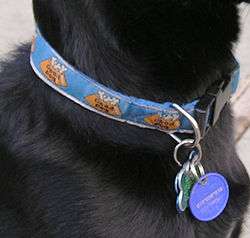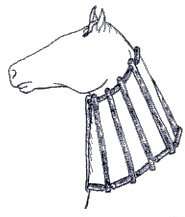Collar (animal)
An animal collar is a device that attaches to the neck of an animal to allow it to be harnessed or restrained.
- Pet collar. A piece of material put around the neck of certain pet animals, such as dogs, cats, or pigs, for control, identification, or other purposes. Identification tags and medical information is often placed on collars. Collars are also useful for controlling the animal, as they provide a handle for grabbing or a means of leading. Similar collars are used with non-pet animals, such as zoo animals and livestock. Pet collars can be made of leather, nylon or metal. Metal collars are normally used for larger dogs. They can come with traditional or quick-release buckles. Collars are sometimes used for fashion purposes.
- Cat collar. Similar to dog collars, but often include a bell to warn of the cat's presence. Collars used on cats are smaller and thinner than traditional dog collars. They can be made of leather, nylon, or other types of materials. Some cat collars are impregnated with flea, tick, and mosquito repellents.
- Anti-bark dog collar, or bark control collar. These collars are predominantly used as a training mechanism. There are a few different types of mechanisms which can be incorporated into anti-bark collars:
- Citronella - The citronella collar releases a spray of citronella-scented liquid when the wearer barks. Most dogs find this scent unpleasant and will resist further barking.[1]
- Static shock - This collar emits a shock through two metal prongs that touch animal's neck. The shock will increase in intensity if the barking continues. This kind of collar is illegal to sell in the UK but is popular in the USA.[1]
- Sonic - Dogs can hear much higher pitches than humans. This collar sends an unpleasant pitch when the dog barks. This collar is tested for each dog to ensure that the pitch is perfectly tuned. [1]
- Vibration - These collars often feature both sound and vibration. Instead of using sonic, they use a low pitched beep when barking begins. This is soon followed by a vibration if barking continues. The vibration is harmless. [1]
- Training collar or shock collar. These collars administer an electric shock to the animal in training, in order to reinforce commands and eliminate any bad habits. It may be combined with an "invisible fence," a signal wire surrounding the dog's permitted area. The dog receives a shock if it strays too near the perimeter.
- Choke collars are also a type of training collars. They are made of different materials with high resistance, such as metal or various composites. This type of collar is suitable for obedience training as it tightens around the neck of the animal if it pulls.[2] It is mainly used on dogs.
- Insect collar or flea collar. Impregnated with chemicals that repel or kill external parasites, they are often a supplementary collar worn in addition to the conventional buckle collar. The effectiveness of flea collars is arguable. Although they are convenient because of their cost and accessibility, the insecticide within the collar is most effective in the neck and face area and does not provide full and complete coverage. Flea collars are considered to be more effective in preventing infestation with external parasites rather than treating an active infestation. Flea collars are best used when a proper disinfestation has been performed, both indoor and outdoor. These collars are primarily worn by cats and dogs. A number of the insecticides used in these flea collars are toxic.[3]
- Pig hunting dog collar. This collar integrates a wide collar and a breastplate for dogs that hunt pigs. They are made from multiple layers of extra tough fabric or leather to protect the vital carotid artery and jugular vein of pig hunting dogs should they be attacked. Some of the pig hunting dog collars come in the form of a full-body protection collar. These collars provide good protection for the dog's chest, neck and rib cage.[4]
- Elizabethan collar. Often made of plastic, this collar is shaped like a cone and used to prevent an animal from self-harm, such as a licking at a wound.
- Tie-up collar. Used for bulls and other cattle, this may be a chain (sometimes covered in plastic hose), or a collar of heavy leather or synthetic material fastened with a heavy duty buckle.
- Animal tracking collar. Used for tracking animal migration or to locate lost pets. In its simplest form, it contains a radio beacon to allow the location of the animal to be determined. More sophisticated devices may contain a GPS tracking unit to record the animal's tracking pattern. Other sensors record water depth or other environmental information and use a mobile phone or other radio transmitter to report location and other data. It may have a timed or remotely controlled release device.
- Horse collars.
- Full collar or Horse Collar. Used for horses or other draught animals, this consists of a robustly constructed leather device stuffed with straw or other material that sits comfortably on the animal's shoulders around its lower neck, supporting a set of hames that transfer the draught forces from the animal to the traces.
- Breast collar or breastplate. Two forms: One is a simpler type of draught collar for lighter loads, consisting of a padded strap around the chest of the animal. The other is similar, but is attached to a saddle and used when riding a horse to prevent the saddle from sliding back.
- Horse tie-up collar. A collar designed to teach horses to tie up and to tie stallions at public events. It is constructed from double-stitched wide leather (sometimes fleece lined), with heavy duty dees sewn into each end. The collar is placed on a horse just behind the poll strap of a headcollar (headstall) which is used in conjunction, and a strong rope passes through the headcollar to secure the two dees so that the horse's wind is not impaired in any way. This manner of application will reduce the likelihood of the collar slipping and injuring or choking the horse. Sometimes used for tethering horses, they are expensive and are potentially dangerous if the horse should become entangled in the tether or frightened, etc.[5]
- Mare collar. A simple buckled neck strap that has a plastic ID tag attached.
- Headcollar or halter. Not strictly a collar, this consists of straps around the head for tethering, tying or leading horses or other livestock.
- Cribbing or wind-sucking collar. The "Nutcracker" collar is an adjustable strap with a lightweight aluminium 'nutcracker'. It is placed around a horse's neck to help prevent windsucking by stopping the flexing of the neck muscles whenever it tries to suck in air.
- Cornell collar. A device developed for use on racehorses to prevent dorsal displacement of the soft palate during racing.[6]
- Neck cradle. Used on horses to prevent them chewing at injuries and dressings.
A yellow neck strap on a racehorse.
- Neck strap. A simple narrow leather strap buckled around a horse's neck to give security to jockeys and other riders. Another form of neck strap (or rope) is the one used by cowboys when roping. This style is shorter and placed closer to the horse's head with the lariat passing through in order to keep the horse facing the calf after it has been roped. It also refers to the part of a martingale, which buckles around the horse's neck.[7] A loose neck collar is also used on harness racing horses when the reins are passed through.
Tie up collar correctly used with a headcollar on a stallion

Nylon quick-release buckle collar on a dog with identification and medical tags.

Wooden neck cradle
Safety collars are designed for pets that live in crates or that might get tangled in tree branches. There is a particular type of safety collar which is intended for both dogs and cats. Breakaway collars are especially designed to prevent the pet from choking or getting stuck. They feature a clever design that releases quickly when a small amount of pressure is applied, such as a cat hanging from a tree branch. The clasp will release, which quickly frees the pet from a possibly desperate situation.[8] However, it is recommended that pets have their collars removed before sleeping in a wired crate.
See also
| Wikimedia Commons has media related to Dog collars. |
| Wikimedia Commons has media related to Horse collars. |
References
- "The Beginner's Guide to Using an Anti Bark Collar for Dogs - Pet's Finest". petsfinest.co.uk. Retrieved 30 December 2018.
- "Silent Training Choke Collar". Retrieved 4 June 2010.
- Flea Collar – Do They Work or Endanger Your Pet? - The Bug Squad, Updated 2012
- "Duncan's Full Body Collar". Archived from the original on 7 June 2010. Retrieved 4 June 2010.
- Code of Practice for Tethering Equines
- Cornell Collar Archived 19 August 2008 at the Wayback Machine
- Bucklin, Gincy Self. "How Your Horse Wants You to Ride: Starting Out, Starting Over". Google Books. Howell Book House. Retrieved 30 May 2011.
- "Safe Pet Collars Deals". Archived from the original on 9 May 2010. Retrieved 4 June 2010.
- The Horse Breeding Farm, Larryann C. Willis, AS Barnes & Co., New Jersey, 1973
- FIRST EXPOSURE: Why Women From All Over the World CAN NOT RELAX From ” A Magical ” Amazing New Cat Flea Collars?, Derothschilds News, 13 April 2018
This article is issued from Wikipedia. The text is licensed under Creative Commons - Attribution - Sharealike. Additional terms may apply for the media files.